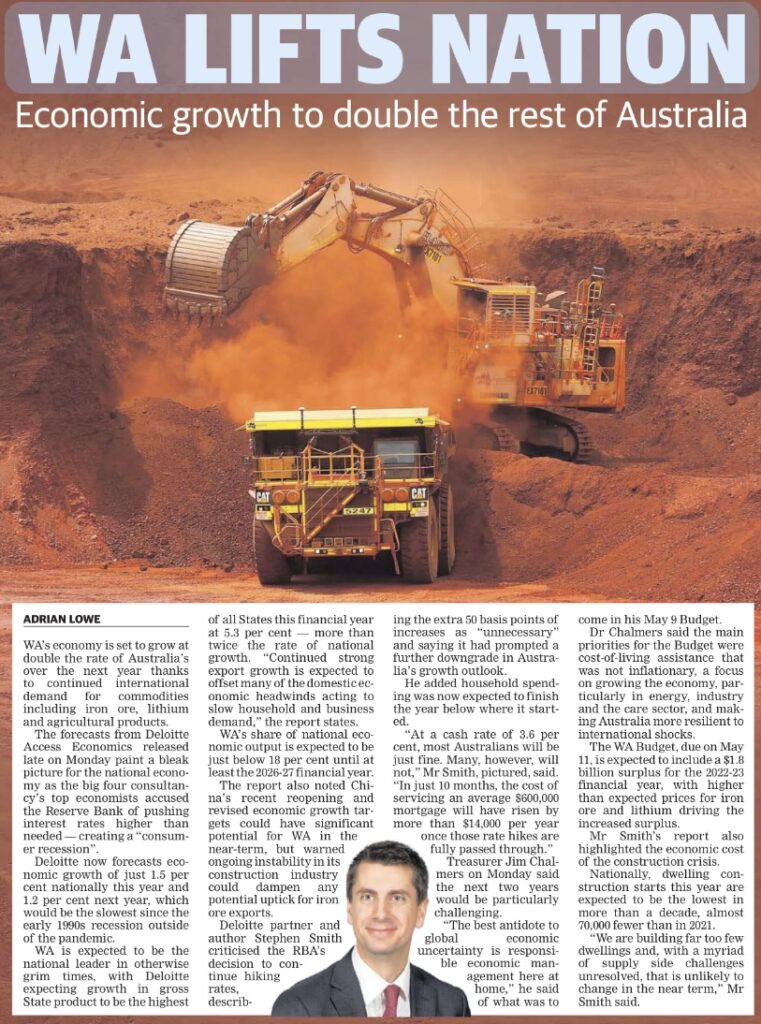
Article by Adrian Lowe courtesy of the West Australian.

WA’s economy is set to grow at double the rate of Australia’s over the next year thanks to continued international demand for commodities including iron ore, lithium and agricultural products.
The forecasts from Deloitte Access Economics released late on Monday paint a bleak picture for the national economy as the big four consultancy’s top economists accused the Reserve Bank of pushing interest rates higher than needed — creating a “consumer recession”.
Deloitte now forecasts economic growth of just 1.5 per cent nationally this year and 1.2 per cent next year, which would be the slowest since the early 1990s recession outside of the pandemic.
WA is expected to be the national leader in otherwise grim times, with Deloitte expecting growth in gross State product to be the highest of all States this year — at more than twice the rate of national growth.
“Continued strong export growth is expected to offset many of the domestic economic headwinds acting to slow household and business demand,” the report states.
WA’s share of national economic output is expected to be just below 18 per cent until at least the 2026-27 financial year.
The report also noted China’s recent reopening and revised economic growth targets could have significant potential for WA in the near-term, but warned ongoing instability in its construction industry could dampen any potential uptick for iron ore exports.
Deloitte partner and author Stephen Smith criticised the RBA’s decision to continue hiking rates, describing the extra 50 basis points of increases as “unnecessary” and saying it had prompted a further downgrade in Australia’s growth outlook.
“The additional 50 basis points of increases earlier this year were unnecessary, and have prompted a further downgrade in Australia’s growth outlook,” partner Stephen Smith said. He added household spending was now expected to finish the year below where it started.
“At a cash rate of 3.6 per cent, most Australians will be just fine. Many, however, will not,” Mr Smith, pictured, said. “In just 10 months, the cost of servicing an average $600,000 mortgage will have risen by more than $14,000 per year once those rate hikes are fully passed through.”
Treasurer Jim Chalmers on Monday said the next two years would be particularly challenging, with the global economy volatile and vulnerable.
“The best antidote to global economic uncertainty is responsible economic management here at home,” he said of what was to come in his May 9 Budget.
Dr Chalmers said the main priorities for the Budget were cost-of-living assistance that was not inflationary, a focus on growing the economy, particularly in energy, industry and the care sector, and making Australia more resilient to international shocks “that we are becoming more and more accustomed to”.
“The uncertainty and volatility in the global economy will be a really key influence on the Budget that we hand down,” he said.
The WA Budget, due on May 11, is expected to include a $1.8 billion surplus for the 2022-23 financial year, with higher than first expected prices for iron ore and lithium driving the increased surplus.
Mr Smith’s report also highlighted the economic cost of the construction crisis. Nationally, dwelling construction starts this year are expected to be the lowest in more than a decade, almost 70,000 fewer than in 2021.
“We are building far too few dwellings and, with a myriad of supply side challenges unresolved, that is unlikely to change in the near term,” he said, adding that the current numbers barely keep pace with population growth — let alone addressing the critical undersupply.
New home lending activity has fallen most in WA compared to all other States and Territories.
In a separate report, AMP deputy chief economist Diana Mousina warned that the only solution was a lift in housing construction, and governments at all levels needed to step up.